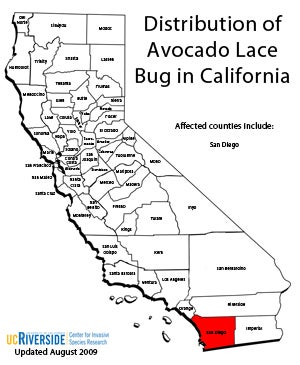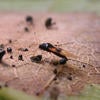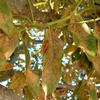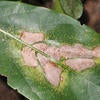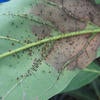Avocado Lace Bug,Pseudacysta perseae
The Situation: Avocado lace bug, Pseudacysta perseae, was first described in Florida in 1908 from specimens collected in this state over the period 1897-1907. Avocado lace bug is a true bug with sucking mouth parts. The common name "lace bug", is derived from the highly reticulate "lace-like-patterning" of the thorax and wings of adults. There are around 1,820 species of lace bug and 154 species are found in North America. Some lace bug species in the U.S.A. are important ornamental pests attacking azaleas and rhododendrons.
Avocado lace bug is known from Florida, Georgia, and Texas (U.S.A.), Bermuda, Cuba, the Dominican Republic, Jamaica, Puerto Rico, U.S. Virgin Islands, (all in the Caribbean), and the east and west coasts of Mexico, and French Guyana in South America. Avocado lace bugs were first detected in California on backyard avocado trees in the Chula Vista and National City areas south of the City of San Diego, California in September 2004.
Adult avocado lace bugs are small winged insects about 2 mm in length (slightly longer than 1/16 inch) with black bodies, yellow legs and antennae, and are visible to the naked eye. The insects live in colonies on the lower surfaces of leaves, often with adults, eggs and nymphs together. Eggs are laid in an irregular pattern, sometimes in loose rows, stuck to the lower leaf surface and are covered with irregular globules of a black, sticky tar-like substance excreted by adults. These sticky exudates may protect eggs from attack by natural enemies.
The eggs hatch into wingless young called nymphs. The nymphs go through gradual metamorphosis shedding their exoskeleton several times as they grow in size, finally developing wings and becoming flying adults. The nymphs are dark red-brown to black and covered with spines. They feed for approximately two to three weeks before maturing into winged adults, which lay eggs, restarting the life cycle.
Damage: Lace bugs restrict their feeding to the undersides of leaves, inserting their needle-like mouthparts into leaf tissue cells to extract cell contents. Feeding initially causes small white or yellow spots on the surface of the leaves as individual cells dry out. It is suspected that feeding damage can provide entrance for pathogenic fungi, in particular Colletotrichum spp., which are leaf anthracnose fungi. As lace bug colonies grow, brown necrotic (dead) areas develop where there has been heavy feeding damage. These necrotic areas look like tip-burn caused by salt damage, but in this case, the necrotic areas are islands of dead tissue in the interior of the leaf surrounded by living tissue. Heavy feeding can cause striking leaf discoloration and early leaf drop.
Other signs of lace bugs are dark, varnish-like excrement and shed white nymphal skins on the undersides of leaves. Avocado lace bug nymphs and adults do not feed on fruit, but will likely have a detrimental effect on yield resulting from the loss of photosynthetic capacity in damaged leaves. In recent years, avocado lace bugs have become an economic problem in Florida and the Dominican Republic.
Avocado lace bugs have only been reported feeding on avocado, red bay, and camphor, all members of the Lauraceae family. Experimental evidence from Florida indicates that avocado varieties vary in their susceptibility to feeding damage. West Indian x Guatemalan avocado hybrids appear to be particularly resistant to attack in Florida. Observations in the Dominican Republic indicate that Hass avocados (a Mexican-Guatemalan hybrid) can be severely damaged by lace bug outbreaks with occasional severe infestations causing defoliation and reduced yields.
In California, avocado lace bug populations are restricted to backyard avocado trees in residential areas in San Diego County. This pest has not yet established in commercial avocado groves in San Diego County or elsewhere in California. Over a three year study period, lace bug populations on backyard avocado trees tended to build in July, peaked around September before declining to low densities over January through May.
Research: University of California scientists with colleagues from the California Department of Food and Agriculture have conducted an extensive research program on avocado lace bug in California. This work has involved the evaluation of commercially available natural enemies for use against avocado lace bug eggs, nymphs, and adults that may have potential for use in the development of an Integrated Pest Management program. The research on natural enemies has been complemented by studies that have evaluated pesticides registered for use on avocados for their compatibility with lace bug natural and their ability to kill lace bug nymphs and adults. Together, this work has identified that green lacewing larvae are the most effective natural enemies of avocado lace bug and there are several pesticides that can kill lace bugs which can be tolerated by green lacewing larvae.
Extensive foreign exploration in areas where avocado lace bug is presumed to be native has failed to located egg parasitoids for possible introduction into California.
Analyses of the genetic material of avocado lace bugs in California is being compared to lace bug populations collected from Florida, Texas, the Caribbean, Mexico, and South America to determine the area from which this invasive pest was introduced into California.
More Media on the Avocado Lace Bug
UC IPM Online: Avocado Lace Bug
California Avocado Commission: Avocado Lace Bug
UC IPM Online: Avocado Lace Bug and Its Damage
Center for Invasive Species Research, University of California Riverside
Text and Photos provided by Mark Hoddle
Mark Hoddle, Extension Specialist and Director of Center for Invasive Species Research
mark.hoddle@ucr.edu
Personal Website
Media within CISR is licensed under a Creative Commons Attribution-NonCommercial-NoDerivs 3.0 Unported License. Permissions beyond this scope may be available at www.cisr.ucr.edu/media-usage.

